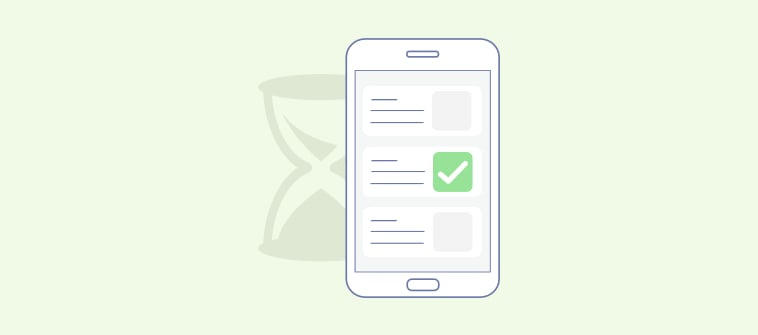As a kid, I had a hard time keeping up with my Maths lessons, often finding myself stuck on one for days. And while I hoped this learning challenge would end sometime in my formative years, it continued well into my professional life.
But I’m not a slow learner; I just have a different learning approach.
It took me years to realize this simple fact and find out what learning method works best for me.
But this doesn’t have to be the case for every learner.
Whether you’re a teacher or trainer, you can use learning style quizzes to identify and implement the best learning techniques for your learners.
We all adapt to a particular method to learn something the best way we can. Some of us read, some watch videos, some listen to audiobooks, etc. The differences in how we understand or comprehend a given piece of information are nothing but a reflection of different learning styles that suit us.
In this article, we will look at how an online learning style quiz helps gauge someone’s learning style, identify knowledge gaps, and give results in the form of grades, deeper understanding, and a more fulfilling educational experience.
What Is a Learning Style Quiz?
If you’re looking to create a learning style quiz that delivers real insights, it helps to start with the basics.
What exactly is a learning style quiz, and why does it matter in a learning or training environment?
A learning style quiz is a type of quiz that you deploy to identify a learner’s learning style & preferences. It helps learners better understand how they retain new information and provides the teachers/instructors with an in-depth insight into learning abilities.
This type of quiz is also known as a learning modality quiz, especially in academic or neuroscience-based education communities.
But before we talk in detail about these quizzes, let’s throw some light on learning styles.
What Is a Learning Style?
To create a learning style quiz that gives meaningful results, you need a clear understanding of what a learning style actually is.
A learning style is a set of factors, behaviors, and attitudes that facilitate learning for an individual in a given situation. In other words, learning styles are different learning methods classified based on their compatibility with individual learners.
For example, the VARK learning style quiz classifies learning methods into Visual, Aural, Read/write and Kinesthetic. Learners with an auditory learning style learn best by listening to information. In contrast, visual learners can comprehend and digest new information quickly when it is presented in the form of charts, graphs, and images.
Let’s learn about the various learning styles an individual can have in the next section.
What Are the Different Types of Learning Styles?
When you create a learning style quiz, you’re often mapping each response to one or more of these common learning styles. Understanding them in detail helps you frame better questions and get more accurate outcomes.
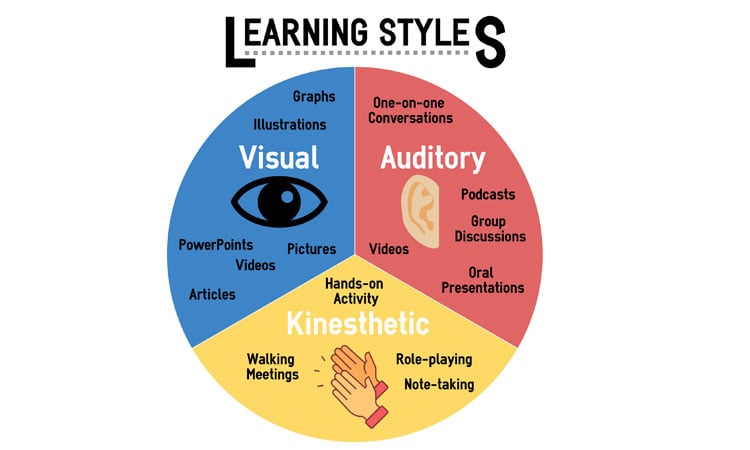
Source: Turningpointcentre
Learning styles differ based on delivery method and can suit individuals and groups accordingly. Some learners use a mix of learning styles, while others stick to a single one.
Here are the most popular ones:
| Style | Learning Preference | Best Methods |
|---|---|---|
| Visual | Images, diagrams, spatial layout | Charts, videos, mind maps |
| Auditory | Sound, music, rhythm | Lectures, podcasts, verbal teaching |
| Verbal | Words, reading, writing | Quizzes, reading material, summaries |
| Kinesthetic | Touch, movement, hands-on tasks | Role-plays, practice-based learning |
| Logical | Systems, logic, numbers | Problem-solving, categorization |
| Social | Collaboration, group work | Peer learning, group discussions |
| Intrapersonal | Reflection, solo learning | Journals, solo quizzes, self-pacing |
1. Visual
In the visual learning style, learners learn by observing things. They respond to colors, images, diagrams, and fonts. Instructors can use slide presentations, videos, or image-based questions to address this learning style. Visual learners learn by visualizing the information presented to them.
2. Auditory
In the auditory learning style, learners learn with the help of sound and music. Auditory learners typically have a good understanding of rhythm. Sound and music are great stimulators in this type of learning. The learners in this category are good listeners and learn best through verbal presentations.
Instructors can use lectures and speeches to address this type of learning style.
3. Verbal
In a verbal learning style, learners prefer the use of words and speech in learning. Verbal learners tend to have excellent vocabulary and are good at all activities relying on heavy usage of words, such as speaking, presenting, and debating.
Teachers, coaches, and trainers can improve learning for verbal learners by encouraging them to take notes and written tests or quizzes.

4. Kinesthetic
Kinesthetic learning usually involves learning through physical activities. Kinesthetic learners have a good sense of touch and respond better to sports or any activity that engages their senses to provide learning.
A good way to achieve the best learning outcomes for kinesthetic learners is by including games and activities that involve the active use of hands and body.
5. Logical
The logical learning style involves an inclination toward numbers, reasoning, and logic. Logical learning applies problem-solving strategies and scientific reasoning. Logical learners look for patterns and logic to quantify answers and work through problems.
You can use deductive reasoning skills, numbers, and letters to teach various concepts, create hypotheses from the coursework, and prove them logically.
6. Social
Learners with the social learning style learn best in groups. They have fluent verbal skills, are great communicators, and love collaborations, brainstorming sessions, and discussions.
To hone social learning skills, you can create online learning groups, peer-review tests, encourage group studying, and more.
7. Intrapersonal
The intrapersonal learning style reflects a penchant for self-studying and solitude. Learners with intrapersonal learning styles love to learn in a quiet environment and enjoy tests and quizzes for self-assessment.
Most learners are a mix of these styles, which is why a flexible, well-designed quiz can uncover dominant preferences while allowing room for blended strategies.
In the next section, check out how online quizzes can help uncover and leverage learning styles.
Importance of Learning Style Quizzes
If you’re planning to create a learning style quiz, it helps to first understand why these assessments matter. They’re more than just tools to keep learners engaged—they make your teaching measurable, targeted, and more effective.
The above section underscores that effective teaching involves much more than just conveying to learners what you, as an instructor, know and what you expect them to know.
Understanding how students learn is a crucial aspect of good teaching.
Gaining this understanding requires a detailed learning assessment. You have to get into your learners’ shoes to find out whether the teaching imparted to students made any difference to their existing knowledge.
Identifying a learner’s learning style or how they learn best and catering to those needs can dramatically affect how they understand and connect with the different topics taught.
Learning style quizzes for kids and adults provide the easiest way to check your teaching methodology’s effectiveness and find out students’ learning styles.
They also support differentiated instruction—a key method in modern classrooms—by helping educators tailor content delivery based on individual learning needs. In some cases, a learning style exam is administered formally to measure instructional effectiveness and inform curriculum planning.
Once you’ve identified a student’s learning style, you can use quizzes to complement your learning material and tailor it to your students’ needs and preferences.
Deborah Smith, an instructor of integrated anatomy & physiology at Shiatsu School of Vermont, experienced that creating quizzes with an online quiz maker for teachers helped her create a learning loop for her students.
This loop ensured students didn’t just receive information, but interacted with it repeatedly through quiz-based reflection, boosting retention through active recall. She was able to add diagrams and pictures in the quizzes, which is especially important for learning anatomy and physiology.
With quizzes, the students would get immediate feedback, and so they would use quizzes as a study aid. According to her, the ease of using the quizzes for studying also impacted the students’ final grades.

An engaging quiz with a mix of question types, instant feedback, and automated grading enables learners to reach successful levels of understanding using their preferred learning style.
Here are some other reasons why you must make learning style surveys and quizzes a part of your training or teaching tools:
- Quizzes are visually appealing and interactive, which keeps students engaged.
- They also help encourage learners to think about how they learn and what they need to be successful.
- A quiz can have multiple attempts for those who benefit from repetition to fully grasp the course/instructions.
- Being highly flexible, quizzes can help address different learning styles. For example:
- Audio & video-based questions can help auditory and visual learners understand concepts and test retention.
- Intrapersonal learners can take learning style quizzes whenever they’re comfortable to learn on their own.
- Social learners can benefit from quizzes conducted as group activities or online quizzes that can have collaboration groups on social media or otherwise.
- Verbal learners who like to learn using printed material can print the quizzes.
- Quizzes help track learner progress, and the detailed reports help instructors create advanced learning paths for each learner.
Beyond learner engagement, these quizzes empower instructors with actionable insights. With every response, you get a clearer picture of what’s working, what isn’t, and where personalized learning interventions can make the biggest difference.
Now real quick, let’s look at the steps you need to take to create a learning style quiz.
FREE. All Features. FOREVER!
Try our Forever FREE account with all premium features!
How to Create a Learning Style Quiz
Once you’ve identified the need for a learning style quiz, the next step is to create one that’s accurate, engaging, and easy to deliver.
The good news is that with a reliable online quiz maker, the process is quick. Many tools even support AI quiz generation, so you can go from topic to quiz in just a few clicks without starting from scratch.
Here are the steps:
Step 1: Click “Create a Quiz” on your quiz dashboard.
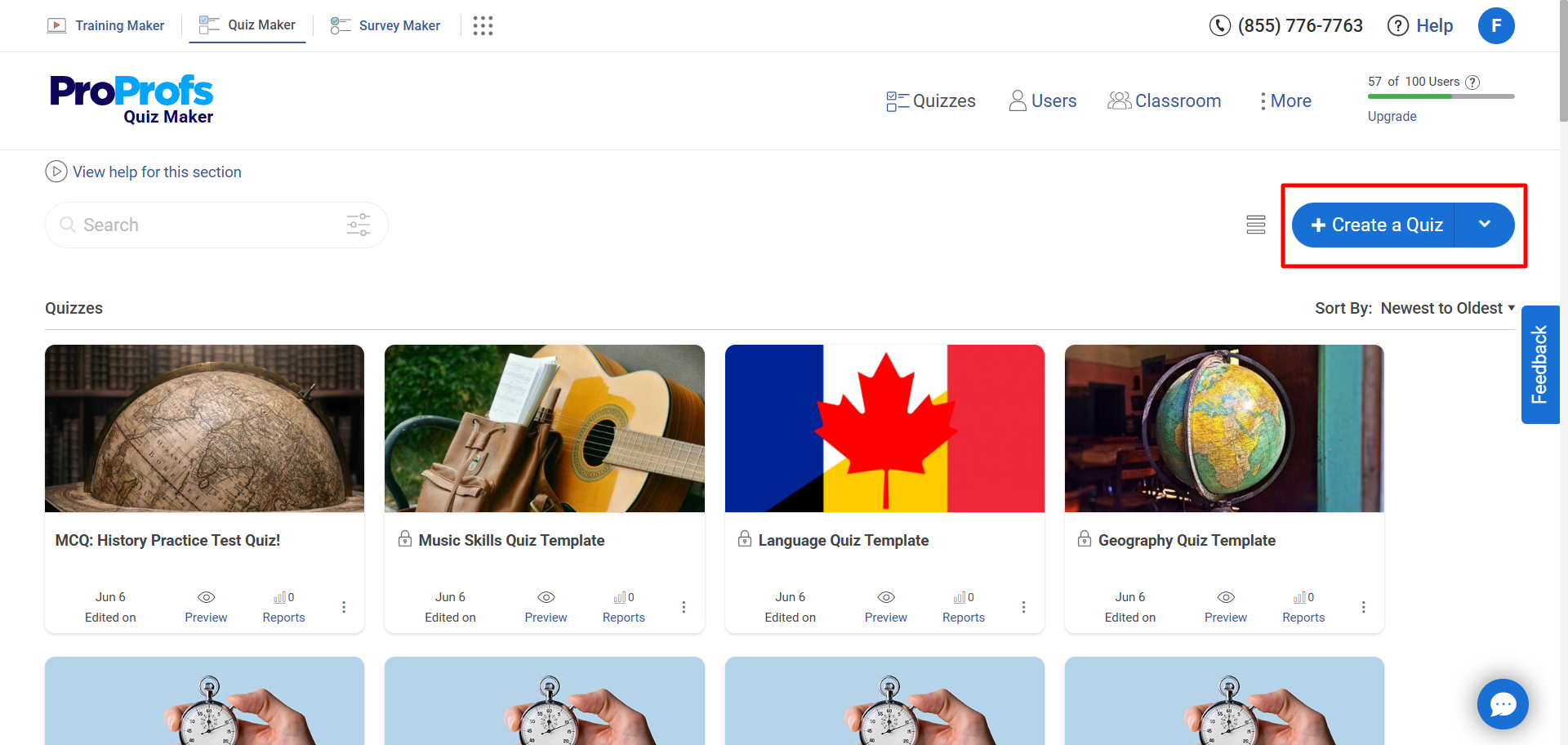
Step 2: On the next page that appears, choose between a scored and personality type of learners quiz and click “Create Your Own” or “Create With AI.”
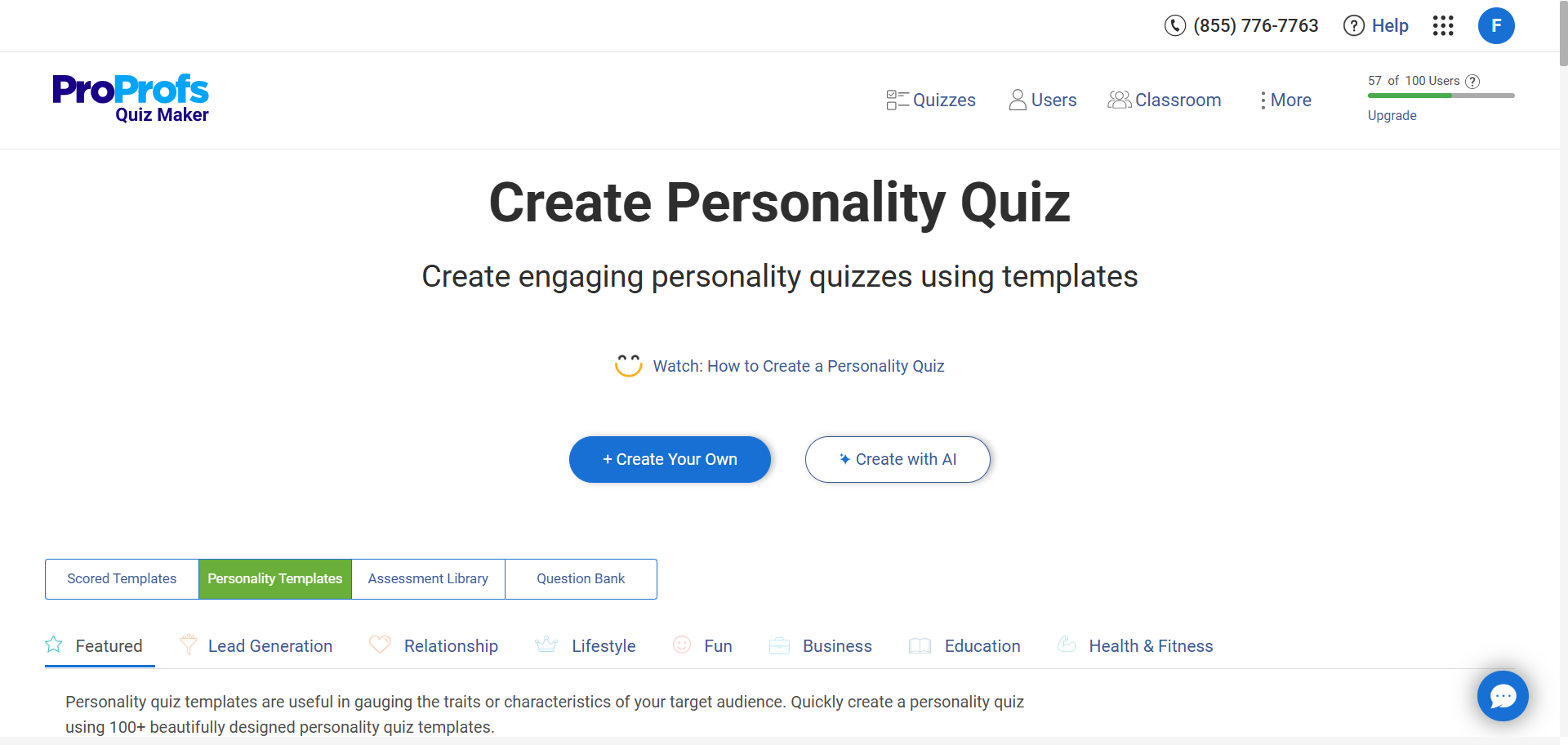
Alternatively, you can explore customizable quiz templates and 100,000+ ready-to-use quizzes and use any of them to create your quiz in minutes.
If your goal is to help learners discover their dominant learning style (such as Visual or Kinesthetic), go with a personality-style quiz. If you want to test how well they learn through specific content formats, a scored quiz with instant feedback may work better.
Watch: How to Create a Quiz Using Templates or Ready Quizzes
Step 3: In the quiz editor, start building your quiz by adding questions manually or importing them from our question bank with 1,000,000+ ready-to-use questions.
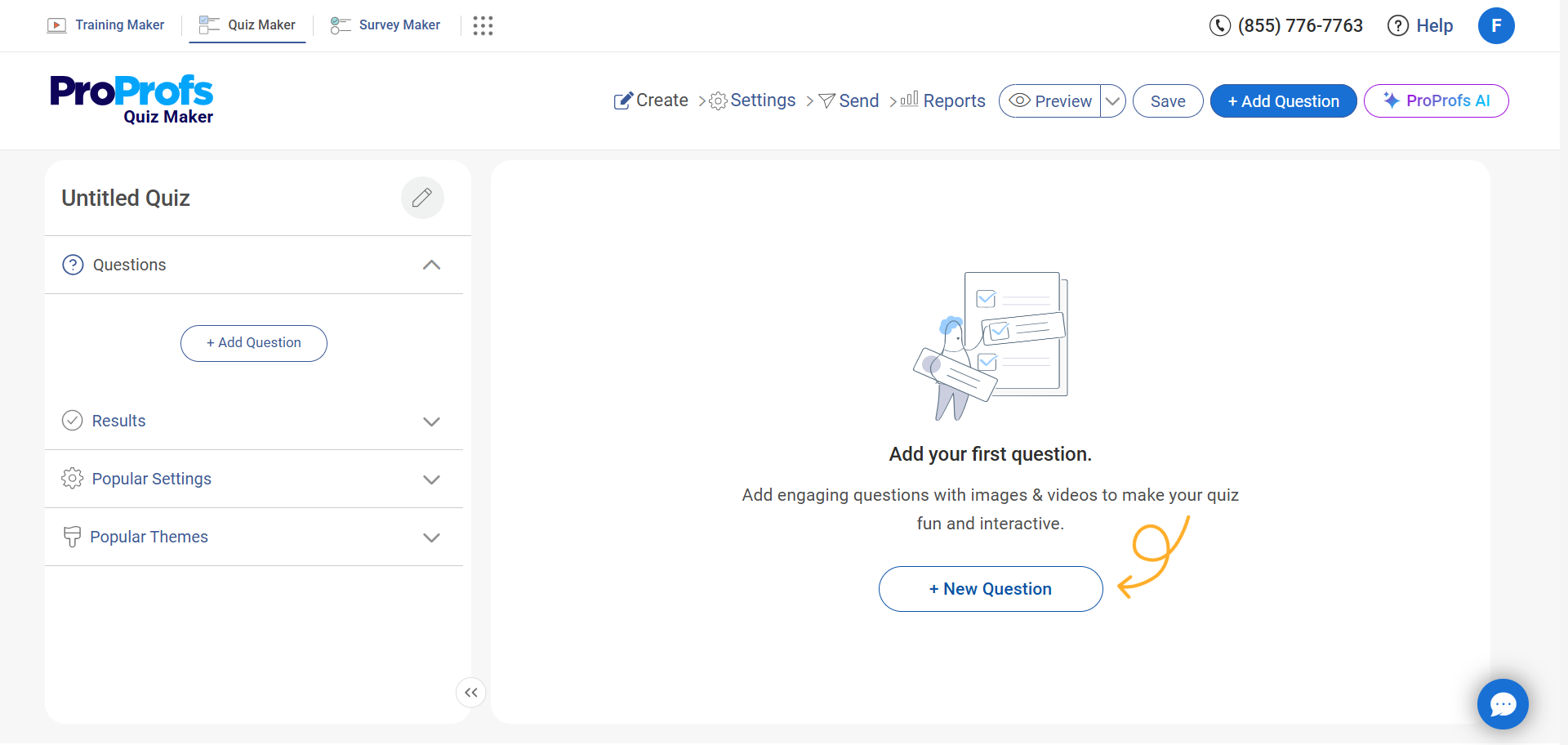
You can use a single type of question to build your quiz or use a mix of question types, such as:
- Multiple-choice
- True/False
- Matching
- Dropdown
- Hotspot
- Audio/video-response
- And more
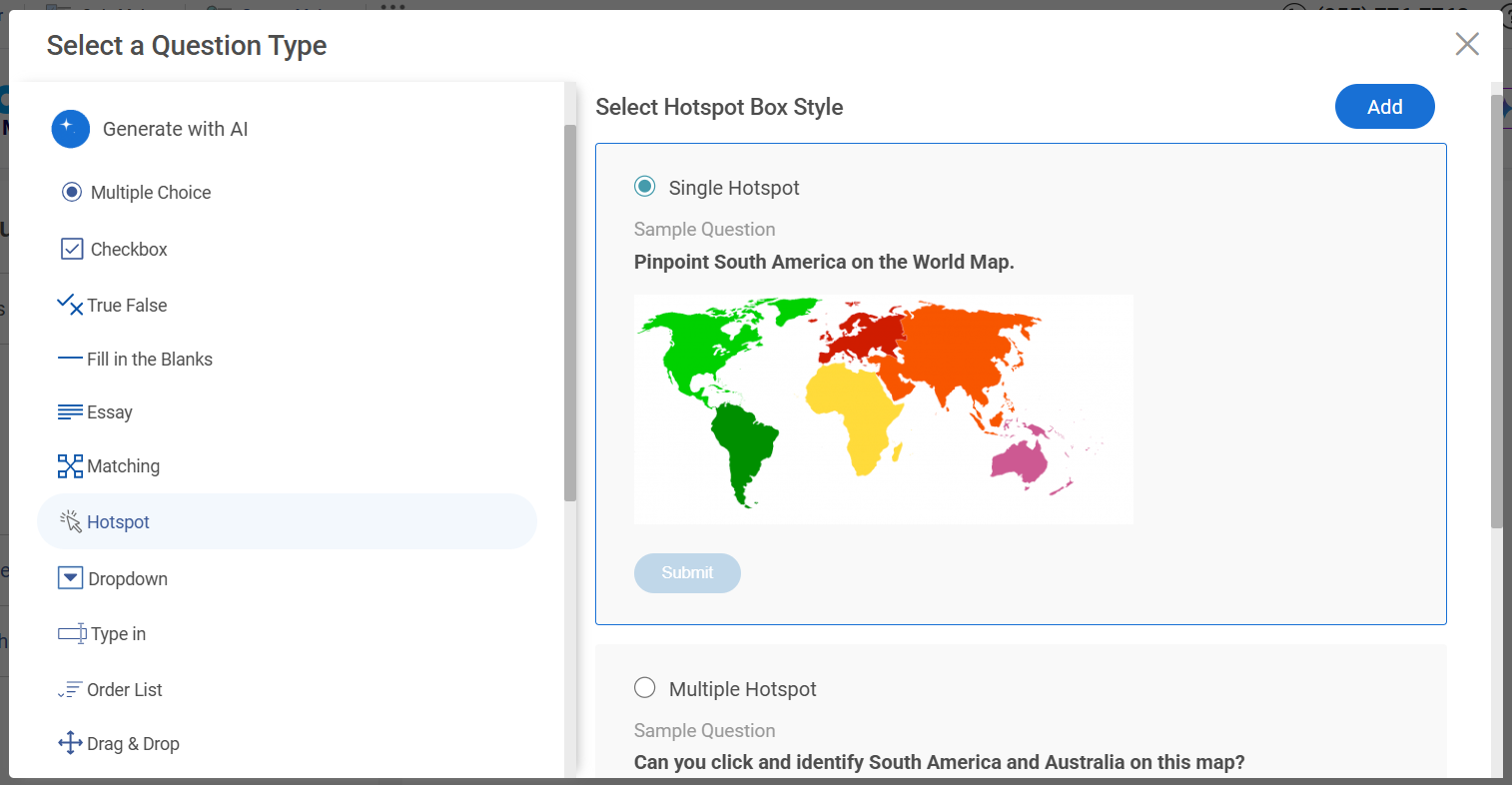
You can also use an AI quiz generator to instantly create questions from a topic, article, video, or learning outcome. This is especially useful if you’re short on time or want your quiz aligned with specific learning style models like VARK or Kolb’s Learning Cycle.
Watch: How to Create a Quiz Instantly With AI
Step 4: Create and map personality outcomes (for personality quiz) or set up scoring and point assignment (for scored quiz).
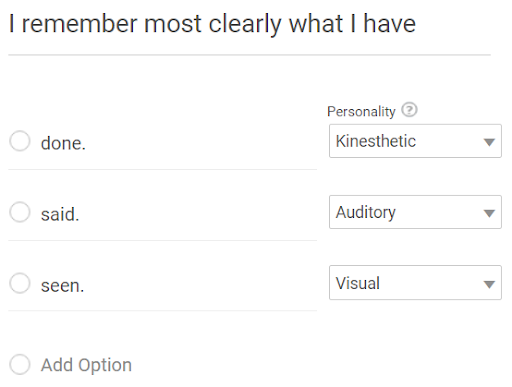
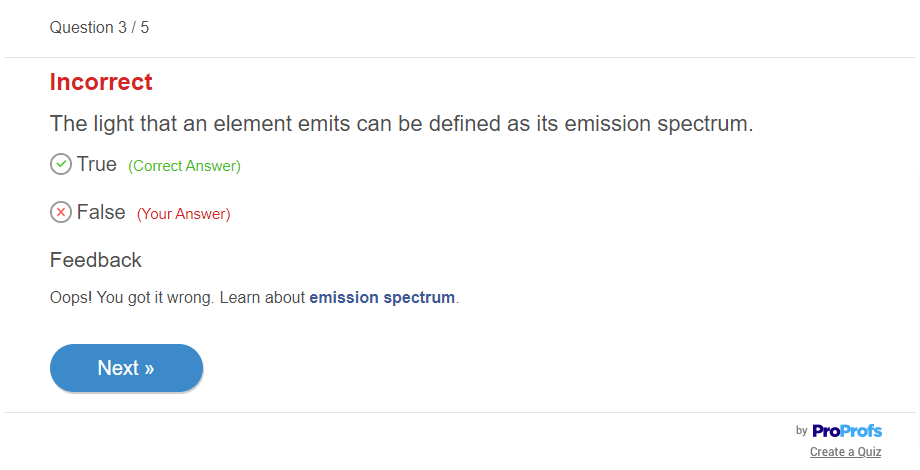
Step 5: Configure settings for customization, cheating prevention, and more.
Once your quiz is ready, preview it from the learner’s point of view. This helps you catch any confusing instructions, media issues, or scoring errors before sharing it.
That’s it. These are all the steps you need to follow to create an effective online learning style quiz.
After that, sharing your quiz is simple. You can send it via a private link, email, QR code, embed it on your website, or assign it through a virtual classroom.
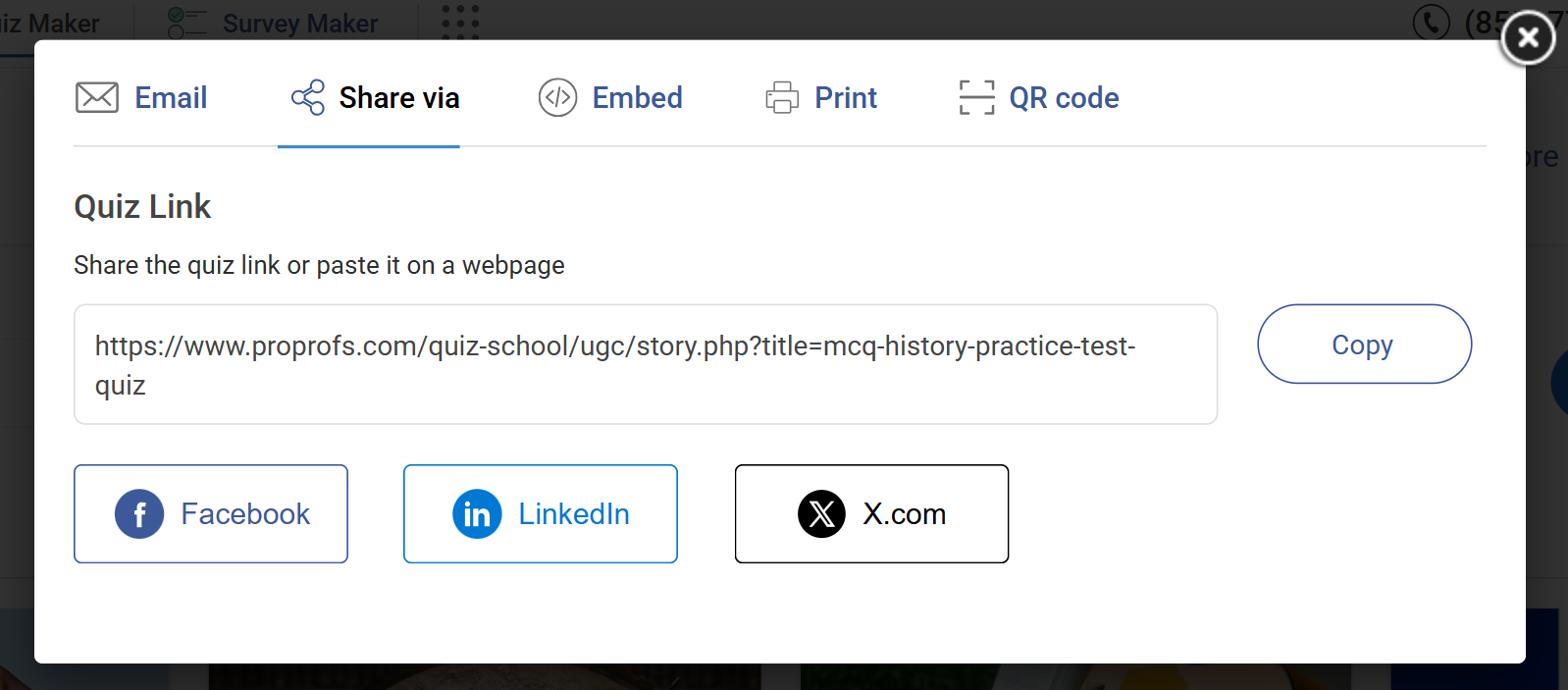
Want to explore a real example?
Check out this learning style quiz to see how it works in action.
Creating a quiz requires only a few steps. But to perfect it, there are a few more things that you must do. Read about them in the next section.
Top Tips to Create a Learning Style Quiz
These are a few simple things you can do to further improve your learning style quizzes:
1. Use Professionally Designed Templates
Creating a quiz from scratch will give you a chance to show your creativity, but creating a quiz with the help of professionally designed templates will save a lot of time and effort. Plus, these expert-built templates generally follow the latest trends in design.
2. Import Questions From the Quiz Library
When creating a quiz from scratch, thinking about the questions to add could take up a lot of time. To avoid that, you can import questions from an available question library.
A question library hosts 1,000,000+ ready-to-use questions on thousands of topics. You can search for your topic and then choose from the list of questions that appear.
Importing questions from the question library can save you hours of work.
3. Add Images, Videos, and Audio Clips to Questions
Using images and other media in your quiz will help you address different types of learning styles.
For instance, by using images in your questions, you can address the visual learners.
You can add an image to the question or attach images as answer options. Associating the correct answer with the image will help learners retain knowledge for longer.
Similarly, you can use videos in your questions. You can either upload a video or embed one from YouTube. Then, you can base your quiz questions on the video.
Here’s an example of a video quiz:
Adding audio clips to your questions will help you address auditory learners.
Here’s an example of a quiz featuring audio clips:
You can also use the video-response question type to address verbal learners.
To further boost engagement, consider mixing stimulus and response formats. For example, show a video (stimulus) and ask learners to respond using a voice recording or choose from image-based answers. This approach mirrors real-life learning scenarios and helps reinforce content retention.
Try to keep the media consistent in terms of tone and style. For example, use the same voice type across audio clips or stick to a particular visual theme. This consistency reinforces clarity and prevents cognitive overload.
4. Give Instant Feedback
The whole point of giving instant feedback is to create a feedback loop for learners. With feedback for incorrect answers, learners don’t have to wait for the results to see where they lacked.
They can instantly see where they made mistakes and go back to studying to improve their learning.
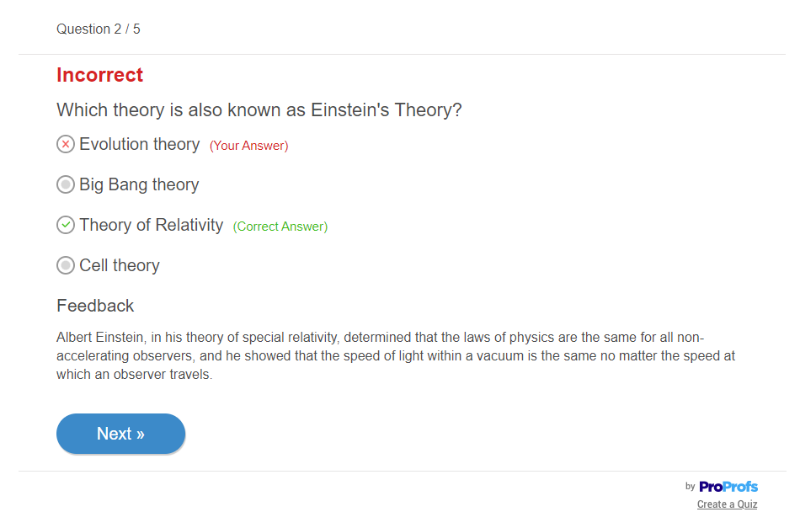
5. Create Helpful Results Pages
For conducting your personality learning style quizzes, merely revealing the learning style isn’t enough. You must create results pages that teach learners the learning strategies they need to employ per their learning style. You can add this information as part of the results page text or add links to online resources detailing such strategies.
You can also include a brief “What to Do Next” section on the results page. This might link to a relevant course, worksheet, or supplementary quiz that helps reinforce the learner’s strengths or work on their gaps.
Avoid Common Pitfalls: When designing your quiz, steer clear of vague questions or overly rigid outcomes. Learning styles should guide instruction, not box learners into fixed categories. Be sure your questions and results reflect this flexibility.
6. Create Online Classrooms
Creating online classrooms can boost learning for those who like to learn in groups (social learners).
You can create different learner groups and then assign them different courses and quizzes. Then, the learners can complete the quizzes and self-assess their performance with their peers.
Watch: How to Set up Your Virtual Classroom in 5 Minutes
7. Configure Settings
After you’ve created your quiz and before you’ve shared it with your learners, configure a few settings such as:
- Question randomization: Randomize the order of questions so that no two learners get the same set of questions. Doing so helps prevent cheating.
- Answer shuffling: Like randomizing questions, shuffling answer options can also help prevent cheating.
- Disabling tab switching: Disable tab switching so learners can’t look up answers on the web when taking a quiz or exam.
- Availability: Adjust the time & date to configure your quiz availability.
- Password-protection: Protect your quiz with a unique password to avoid unauthorized access.
8. Access AI-Generated Reports & Statistics
What good is a learning quiz if you can’t identify knowledge gaps at the end?
To carefully ascertain the strengths & weaknesses of your learners, access the auto-generated reports & statistics.
Reports can include all the important big or small details, such as:
- The number of incorrect & correct answers
- The average time spent completing the quiz by your learners
- The time spent answering individual questions
- The questions learners found most difficult
Having details like these at your fingertips can help you assess your quiz’s overall difficulty level and help identify the knowledge gaps. Using the details given in the reports, you can improve your courses, lessons, or instructions.
How to Interpret Quiz Results and Apply Them to Instruction
A learning style quiz becomes truly valuable when its results lead to real instructional impact. Here’s how to turn insights into meaningful action:
1. Recognize Primary and Overlapping Styles
Learners often show a blend of preferences. Instead of treating quiz results as rigid labels, identify their dominant and secondary styles. For example, someone may lean visual but also respond well to logical structuring. This layered insight helps you design multi-modal experiences that feel natural.
Handling Mixed or Borderline Learning Styles
Some learners may not show a clear dominance in one learning style. Their quiz results might reveal equally strong tendencies across multiple styles, such as both visual and kinesthetic, or auditory and logical. Instead of forcing them into a single category, treat the result as a blend.
Provide multi-modal resources and encourage experimentation.
For example, a learner with both visual and logical leanings might benefit from infographic-style diagrams that explain processes step by step. A blended result isn’t a limitation. It’s an opportunity to personalize instruction even further.
2. Refine Your Content Delivery
Use what you learn to tweak, not overhaul your materials. If the learner prefers auditory input, consider adding narration to a slide deck or providing a quick voice note recap. For kinesthetic learners, break longer lessons into quick tasks with physical or interactive components.
3. Reorganize Group Dynamics Thoughtfully
When working with cohorts, learning styles can inform how you form peer groups. Social learners may benefit from collaborative tasks, while intrapersonal learners could be paired with mentors or given space for reflection. Group structure affects engagement more than most instructors realize.
4. Stay Open to Evolving Preferences
Quiz results capture a snapshot, not a permanent truth. Monitor how learners respond over time. If a student shows signs of disengagement despite content alignment, revisit their preferences or encourage them to explore alternative formats.
5. Prompt Learner-Led Strategy Shifts
Empower learners to act on their results. Include simple suggestions like “Try sketching this process if you’re a visual learner” or “Summarize the concept aloud if verbal input helps you.” These nudges help learners take ownership of their methods and deepen retention.
Personalize & Empower Learning
Learning style quizzes give you clear insight into how each person learns best. With that understanding, you can adjust your teaching approach to match individual preferences and help learners try new strategies that improve retention and confidence.
Whether you’re teaching students, training employees, or guiding individual clients, these quizzes reveal learning patterns that might not be obvious through observation alone. They also encourage learners to think about how they learn, which helps them take a more active role in their development.
You can create your first free learning style quiz in just a few minutes with ProProfs. Use a pre-built template, select questions from the library, or generate a quiz using AI. After the quiz is completed, you’ll receive a detailed report with insights into learning styles, progress, and improvement areas—so you can take the next step with clarity.
Frequently Asked Questions
How do I validate the accuracy of a learning style quiz?
To validate a learning style quiz, compare its results with well-known assessments or see if they match how people actually prefer to learn. Ask educators or experts to review the quiz content and see if it matches proven research. Test for reliability by seeing if the quiz gives similar results when taken more than once, and check if all questions consistently measure the same learning style pattern.
What are the ethical considerations when assigning learning styles?
Here are some key ethical considerations to keep in mind when assigning learning styles:
- Avoid labeling learners: Don’t treat learning styles as fixed categories. People learn in different ways depending on the situation.
- Use results as a guide, not a rule: Learning style quizzes should help suggest strategies, not restrict choices.
- Respect privacy: Clearly inform learners how their data and results will be used.
- Avoid bias: Ensure your quiz questions are inclusive and do not favor a particular background or learning method.
- Encourage flexibility: Let learners try different learning approaches outside their assigned style.
- Keep communication clear: Explain that learning styles are just one of many tools for understanding preferences, not a scientific diagnosis.
Regularly review and improve your quiz: Stay updated with research and refine your quiz so it supports learners in a fair and meaningful way.
How can learning style quizzes be adapted for corporate training?
Learning style quizzes can make corporate training feel more personal. Start by giving employees a quick quiz before training to see how they learn best—some like visuals, and others prefer hands-on practice or listening. From there, you can mix things up: videos for visual learners, discussions for auditory types, and simulations or VR for kinesthetic folks. This way, you can create flexible, engaging learning experiences for everyone.
What is the best learning style quiz format?
The best format depends on your goals. Use a personality-style quiz to identify a learner's dominant learning style (like Visual or Kinesthetic). If you're measuring content comprehension by style, a scored quiz works better. Both quiz types can function as a learning styles assessment test when aligned with your teaching goals. A mix of question types, such as multiple-choice, image-based, and audio response, helps you reach different learners effectively.
How many questions should a learning style quiz have?
A typical learning style quiz includes 10 to 20 questions. This range is long enough to spot patterns but short enough to keep learners engaged. You can adjust the length based on age group, context, and how many learning styles you want to explore.

 We'd love your feedback!
We'd love your feedback! Thanks for your feedback!
Thanks for your feedback!



